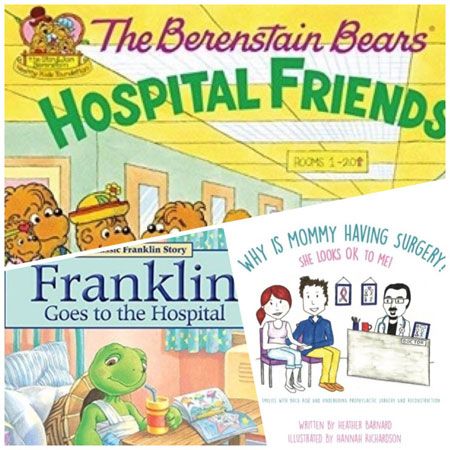
Previously, Zero Breast Cancer reviewed three children’s books written by breast cancer survivors to capture the insights they developed as they ‘winged’ it through their diagnosis and treatment whilst still having young children at home.
This review will look at three more that came to our attention recently. There is a Chicago-based non-profit organization called Bright Pink Support, which focuses on breast and ovarian cancer risk assessment. It has a lively members-only Facebook page where mostly younger women, many of whom have inherited genetic mutations placing them at greater risk for breast and ovarian cancer, provide support and resources toeach other. One particular discussion concerned explaining surgery - whether prophylactic (preventative) or as part of treating already-diagnosed cancer - to younger children. This discussion was the inspiration for this review.
First Book: A Classic Franklin Story: Franklin Goes to the Hospital
Written by Canadians Paulette Bourgeois and Brenda Clark and illustrated by Brenda Clark. This book was published in 2000, although the character has been around since 1986. Find it here.
The characters
Franklin is a turtle whose life, vocabulary, emotional experiences, fears and concerns parallel those of toddlers and early grade school aged kids. He lives with his mom and dad and has lots of friends like Beaver and Fox. His doctor is Dr. Bear and all the hospital personnel, such as nurses and technicians, are animals too.
Topics the book covers
This book looks at the hospital experience from the perspective of Franklin as a patient. It begins with Franklin sustaining an injury whilst playing soccer and the discovery the next day by his doctor that he will need an operation to deal with a crack in his shell. Following Franklin’s journey through the process of having an x-ray taken, the hospital environment, the operating room and the recovery process helps to demystify much about the medical setting that is very alien and intimidating for small children.
How the book is helpful
The recommended target audience for this book is ages 3 years and up. Some stronger first and second grade readers can probably manage this book on their own. Clearly this book would be helpful for a child who has been injured or who is ill. It is not hard to imagine that a younger child could be helped to develop empathy for a sibling or peer in these circumstances. How useful this book would be to help a child make sense of an adult experience of being in hospital for treatment or surgery is not so obvious.
Second Book: The Berenstain Bears: Hospital Friends
Written and illustrated by Mike Berenstain. This book was published in 2015 Published by Harper Collins. Find it here.
The characters
In this book the Berenstain Bear Family, Mama Bear, Papa Bear, Brother Bear, Sister Bear and Honey Bear visit cousin Fred who is in the hospital following an operation to remove his tonsils. As visitors, the Bear family gets the opportunity for a tour led by Dr. Grizzly and learns something about different activities that take place in a hospital.
Topics the book covers
The characters see a pediatric ward and observe the activities that keep even sick kids from being able to participate in reading, learning and creative activities. They visit the physical therapy department and learn about x-rays. Helpfully, they get to see doctors preparing for surgery by washing hands and donning gloves and masks. This provides an opportunity in the book to discuss germs and the importance of protecting patients from picking up infections in the hospital. The next couple of stops include the post-operation recovery room, emergency department reception area, exam room, and inside of an ambulance. The bears even learn that some patients are transported to hospital by helicopter!
How the book is helpful
The recommended target audience for the book is ages 4-8. The book does a good job of providing an overview of what goes on in a hospital. Because the main characters are visitors not patients, the tone of the book is consistently up-beat. The characters are fascinated by and interested in what is going on and do not exhibit any fears. It is likely that this book provides a good overview to kids whose mom (or even dad) may be in the hospital for surgery or treatment associated with breast cancer. The book does not address any fears and anxieties kids may have seeing a parent in such a setting, especially if the parent is in pain or hooked up to monitors, etc.
Third Book: Why is Mommy Having Surgery? She looks OK to me: For families with BRCA risk and undergoing prophylactic surgery and implant reconstruction
Written by Heather Barnard and illustrated by Hannah Richardson. The forward was written by the author’s surgeon, Minas Chrysopoulo, MD. FACS, PRMA Plastic Surgery, Center for Advanced Breast Reconstruction, San Antonio TX. This book was self-published by the author in 2017. Find it here.
The characters
This book was written by a mother who has decided to have a prophylactic mastectomy following the discovery that in her family a pattern of breast cancer is almost certainly due to the presence of a genetic mutation, BRCA1. This surgery is aimed at making her own breast cancer risk negligible and ensuring that she can be around as her family of three children grows up. At the time of her surgery, her children range in ages from 6 - 10. This book more of a work of non-fiction than a “story book.”
Topics the book covers
The three main topics covered are:
- Some of the science of why someone who seems perfectly healthy would need or want to undergo this type of surgery. The book includes an explanation of what the BRCA mutation is and why people who have it might experience more cancer, especially breast cancer.
- What the mastectomy surgery and reconstruction entails: doctors and hospital visits before the surgery, what happens during surgery itself, and the recovery period immediately after surgery.
- Post operative recovery in the days and weeks after the surgery as the author gradually returns to full strength and normal activities.
The book presents information largely about the kinds of questions and concerns that the author’s children expressed or were likely to express. The book presents all the information in a positive way with the expectation that information is the antidote to fear and anxiety.
How the book is helpful
The book is probably best as a read-aloud or read-together book, even for older children. It is also a guide to parents in similar situations, giving them helpful language to use to cover topics that even adults have some difficulty understanding or speaking about with confidence.
The strength of the book is that it is comprehensive but not overwhelming. The book empowers parents and kids to deal calmly and in a matter-of-fact way with something that can provoke anxiety and fear.
The limitations of the book lie in the fact that this is clearly a family who are highly educated and knowledgeable with significant health literacy. They also have an approach to talking about health that doesn’t shy away from discussing cancer in general with kids or talking about Mom’s breasts with their kids. Not all families are this open with or comfortable with such topics.
If you have a family history of breast or ovarian cancer, discuss it with you doctor or a genetic counselor and consider being tested. These healthcare professionals can guide you through risk assessment, genetic testing and making sense of the results. An excellent website for information about inherited breast or ovarian cancer risk is Facing Our Risk of Cancer Empowered (FORCE).
In the event that you do opt for preventative surgery this book will be useful in explaining what is going on to younger children, be they your own kids, grandkids, nieces and nephews, kids of neighbors or friends kids.
Book review written by Rose Barlow, Outgoing Executive Director.

